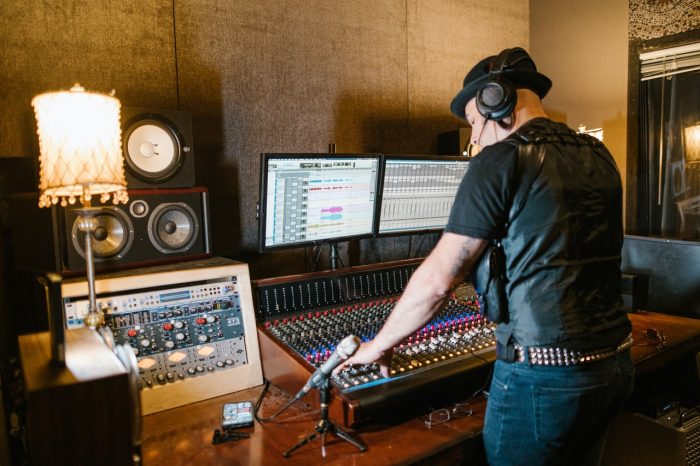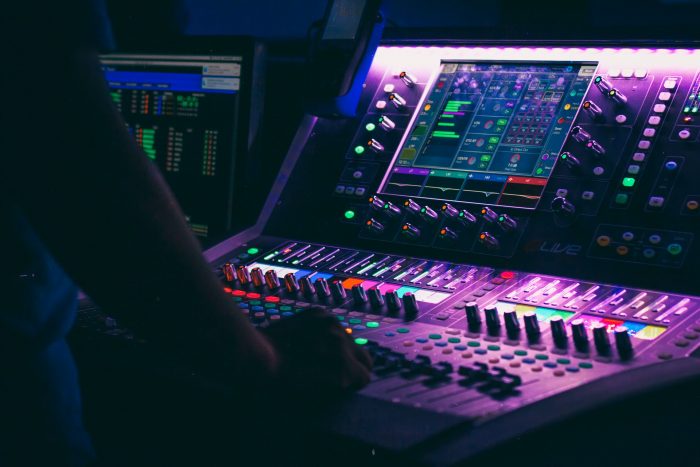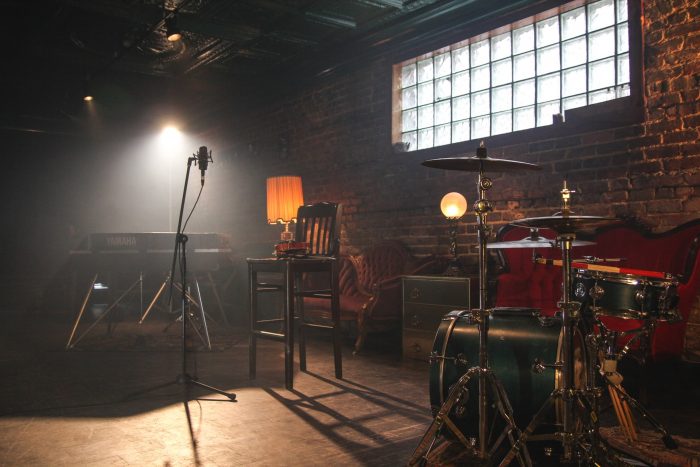Drums make up the backbone of a song. It not only establishes the beat but can also be the most memorable part of a song.
Just like anything else, mixing drums can prove to be very challenging.
If you are new to this, encounters with so many different elements of mixing such as balance, EQ, reverb, compression, bus processing, noise gate, and transient enhancement can look perplexing.
This article is a step-by-step guide that will teach you how to mix drums, and it includes all the tips and tricks I use when mixing drums.

Step 1: Mix bus
Before you can start mixing drums, you need to organize different audio sources.
Multiple snares, kick, or overhead mics need to be sent to their own instrument bus, or you’d have to mix each of them separately.
A mix bus is a way to route one or more selections of audio to specific places such as aux sends, subgroups, and your main L/R mix.
Desired channel or audio is sent to the bus that you choose (Aux Send, Main L/R, VCA, etc.) That signal is fed to the destination you wish by turning up faders or knobs for channels within that bus.
If you have two snare mics, you should set the output of each channel to the same bus and set the input of an aux channel to that bus.
The process will be the same for all other audio sources.
Set the output of each source as a new bus, and then set the input of an aux track as that same bus.
Step 2: Create balance
The next step in learning how to mix drums is finding the right balance.
First, you should solo your drum bus and turn all your mics down.
Then, bring up the most important elements one at a time, usually starting with the kick or the snare. Finally, bring in everything else and balance each drum together until the whole drum set sounds natural.
You need to balance the sound of each element of the kit and the sound of the drums and the other instruments.
To do it, you need to listen to the drum kit and make sure that you can hear each element clearly. The snare is usually the loudest element in the kit, followed by the kick and toms.
You can use the overhead and room mics to make all of the close mics sound united by creating a space for the drums. If you are not sure that you reached the perfect balance, you can use the reference mix.
You can compare the sound of your current mix with some of your best mixes and make sure you are on the right track.
Just listen carefully to each element in the mix and adjust the levels of each drum until you get the balance right.

Step 3: EQ
We came to the fundamental part of how to mix drums called EQ.
Equalization, or EQ, is one of the most well-known forms of audio processing in music production that help you manipulate the frequency response of the instruments in your session.
With EQ, you can the character of an instrument, increase separation, create effects, and more.
Here are some tips and tricks for the EQ of each drum element.
Kick drum EQ
- Remove low-end rumble with a high-pass filter (up to 50 Hz)
- Boost or cut the basic frequency of the kick (between 60 and 120 Hz)
- Take out any muddiness in the low-mids (around 250 Hz)
- Remove excessive room tone in the mid-range (between 250 Hz and 1 kHz)
- Increase the 1 – 5 kHz range if needed to emphasize the snap and attack of the beater
Snare drum EQ
- Take out low-end rumble with a high-pass filter (up to 100 Hz)
- Boost or cut the basic frequency of the snare (between 150 and 250 Hz)
- Remove muddiness or boxiness in the low-mids (between 250 – 500 Hz)
- Take out the ringing in the snare drum with a narrow band (between 500 Hz and 1.5 kHz)
- Increase 3 – 5 kHz to emphasize the snap and attack
- If you want to add sizzle and air, boost 8 kHz and above with a high shelf filter.
Toms EQ
- Cut the mids to get rid of the boxy sound (250 Hz and 1 kHz)
- Boost the lows (80-100 Hz for floor toms, and 250 Hz for smaller toms
- Remove low-end rumble with a high-pass filter (up to 100 Hz)
- Remove muddiness in the low-mids (around 250 Hz)
- Add the attack by boosting from between 5 kHz and 7 kHz, depending on the size of the tom.
Cymbals and Overheads EQ
- High-pass the close-mic’d cymbals (up to 300 Hz) to make room for other low-end instruments.
- Remove muddiness in the low-mids (around 250 Hz)
- Take out the boxiness or excessive room tone in the midrange (between 250 Hz and 1 kHz)
- Make the space for the vocal with a small cut around 5 kHz
- If you want to add sparkle and glimmer, boost above 8 kHz with a high-shelf

Step 4: Use compressor
A compressor is a useful tool if you want to learn how to mix drums because it allows you to control the dynamic range of your sound.
It’s most commonly used to ensure that no sounds in the mix are too quiet.
You can use compressors in many different ways to shape your drum sound.
For example, if you want a punchy and tight snare drum, you can use a fast attack and release time with a ratio of 4:1.
If you want the soft and round kick drum, you can use a slow attack and release time with a small ratio of 1.2:1.
The compressor takes a sound and decreases its volume if it surpasses a certain threshold so that you can lower the volume of the whole track and make sure nothing gets lost.
The first way to do this is by using a slow attack time.
Attack time is how long it takes for the compressor to get going or how long it waits before compressing the signal.
When you have a slow attack time, you’re letting those low, loud sounds come through before applying compression.
This lets those big bass hits sound full and rich while compressing everything else so that they remain steady and consistent in volume throughout your song.
The second way to use compressors on drums is with fast attack times.
This gives those low sounds less room to breathe, which can be great when you want a more punchy-sounding kick drum or snare drum.

Step 5: Use reverb
Reverb is a highly popular effect to use on many different instruments, but it is especially important if you want to learn how to mix drums.
It helps create depth in the sound by adding artificial reflections to the signal.
This can help you make your drum sounds seem as if they are in a much bigger space than they are.
It is important to note that reverb should be applied after the drum sound has been processed with EQ and compression so that you don’t accidentally affect any of these settings by adding reverb.
When mixing drums, you can use different reverbs:
- Room reverb: gives drums the impression that they were recorded in a room, giving them an authentic feel.
- Chamber Reverb: a good choice if you want a natural-sounding, non-electronic reverb for your track.
- Hall Reverb: brings huge and epic sounding, so they’re good if you want a stadium or “live concert” feel for your track.
- Plate Reverb: give your track an “old school” vibe and make it sound like it was recorded in an earlier era.
Step 6: Noise gate and transient enhancement
When learning how to mix drums, you can use noise gate and transient enhancement to your advantage.
A noise gate is designed to eliminate unwanted drum bleed, whereas transient enhancement helps emphasize attack and sustain.
First, let’s talk about the noise gate.
This process is just a way of getting rid of any frequencies you don’t want in your track.
You can set a threshold for the gate. As soon as a signal hits that threshold, it’s simply muted.
This is a great way to keep your mix clean and free from bleeds, but you have to be careful not to accidentally cut out parts of your sound that are actually intentional.
On the other hand, transient enhancement is a completely different technique that results in the opposite effect.
Rather than muting sounds above a certain frequency threshold, you can use a transient enhancement to make those sounds louder.
This is great for emphasizing certain aspects of your drum mix, like attack or sustain.

How do you make drums stand out in a mix?
The volume of the drums will depend on what you’re trying to accomplish.
If you want them to be loud and aggressive, then crank it up.
However, if you want them to be more subtle, you should lower the volume.
If you do want your drums to stand out a bit more, here are some tricks:
- EQ the drums to taste.
- Reduce some low end from the other instruments in your mix if they compete with the kick drum.
- Put a compressor on the kick drum and adjust it to start pumping at about -4 dB. Then turn down the threshold as much as possible without making it sound unnatural or “squishy.” This will make the kick drum sustain a bit longer and seem louder than if it wasn’t compressed.
Should I mix drums first?
When mixing a song, it’s common to hear several different strategies on how to get started learning how to mix drums.
Some engineers might say you should mix the drums first, while others say you shouldn’t.
Let’s check the advantages and disadvantages of both approaches.
Advantages of mixing drums first:
You get a better idea of how to treat the rest of the instruments in your mix.
This is especially true if your song features guitar or other percussion instrumentation that can easily get lost in the snare. If you’re not careful, you’ll get a lot of mud in your mix by default.
By starting with the drums, though, you can get a better idea of what frequencies need to be carved out in order to leave space for those other instruments.
You can save time and make sure everything is working together cohesively.
Disadvantages of mixing drums first:
The downside of mixing drums first is that it can be difficult to go back and make adjustments later, especially if your song has a lot of layers.
If you need to tweak something on your kick drum or snare drum, those changes might affect how the rest of the track sounds.
How do you mix powerful drums?
Drums can be pretty harsh and can easily overtake the sound.
Here are some tips for understanding how to mix drums that have a powerful sound.
For a natural tone, start with a slow attack and a fast release.
More of the initial transient travels through the unit without being compressed when the attack time is slow.
Increase the attack time gradually until you achieve the ideal balance of tight and punchy. For fast drums, quick release times are ideal.

How loud should drums be in a mix?
The first thing to do is make sure your drums sound good on their own.
Put all your faders down, then listen back to the drums.
Don’t forget about the snare!
It’s easy for the snare to get buried in the mix.
Make sure it cuts through and sits nicely with everything else.
The next step is to listen to other songs for reference and see if you can find any patterns in terms of how loud the drums are compared to everything else.
It’s a good idea to do this at several different volume levels.
This will help you get an idea of what works best for different musical styles and genres.
How do you make a snare sound better when mixed?
If you want a snare drum to sound better when mixed, there are a few things you can try.
Here are some tips:
- Use a high pass filter on the track
- Reduce the bass frequency
- Consider whether your reverb is too loud or too quiet
- Try using a gate to cut off the reverb
Should you pan drums?
When trying to make your drum sound fill the entire room, panning is one of your most important tools.
If you want to understand how to mix drums, you should consider panning.
Panning drums to the center
When you pan all your drum sounds to the center, it results in a very mono mix, where nothing stands out.
The kick and snare are also not very present in the mix because they share frequencies with other instruments.
When you have a lot of instruments in your mix, it’s important to leave some space for them.
A good way to solve this problem is by using groups and buses.
You can route all your drum sounds to one bus, then push all those sounds together into one sound source, making it easier for you to control that source.
Panning drums across the stereo field
When you pan drums across the stereo field, it results in a clear separation between each sound source, and when processed correctly, it creates stereo width without compromising its mono compatibility.
A disadvantage is that if you want a more narrow sound, you have to process every individual sound separately, which can be time consuming and confusing.
Should drums be recorded in mono or stereo?
Drums can be recorded in mono or stereo.
Every drum should be recorded as its own instrument.
The kick drum, snare drum, and toms are all recorded separately with individual mics. Therefore, they’re in mono.
The overhead and room mics, on the other hand, are captured in stereo.
If you have enough mics to capture the kick, snare, and toms independently, you should record them in stereo.
This will allow you to mix them separately after recording.
Conclusion
Mixing drums can be complicated for those without knowledge of music production.
However, if you decide to learn how to mix drums, start with the main elements such as mix bus, balance, EQ, compressor, reverb noise gate, and transient.
Many beginners do not know how to mix drums, they understand the music, and they know the sound they want.
So, in addition to learning music theory, one of the best ways to improve your ability to mix on the drums is to take existing songs you like and deconstruct their drum sounds.
Add these components into your own drum mix and practice creating these sounds until you are comfortable with them.
You may be overwhelmed with the amount of information about mixing drums.
However, learning about each aspect of mixing can help achieve better results for you and your mixing projects in the future.
